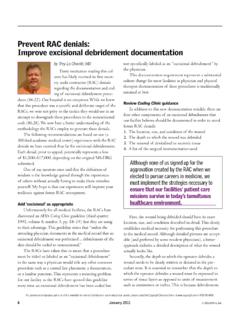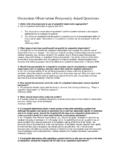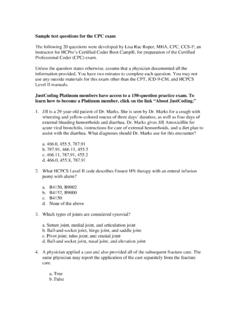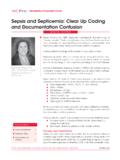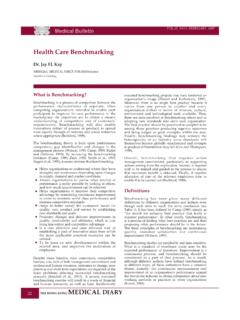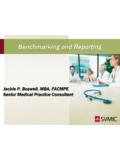Transcription of 2013 Physician Query Benchmarking Survey - HCPro
1 A supplement to CDI Journal2013 Physician Query Benchmarking Survey2013 Physician Query Benchmarking Survey2 Survey shows CDI staff and Query compliance disconnect It has been three years since ACDIS last surveyed its mem-bership about Physician Query practices. In 2010, 382 CDI professionals participated. This year s Survey garnered 517 respondents, primarily CDI specialists. That s really a tremendous response rate, says Drew K. Siegel, MD, CPC, CDI specialist at the University of North Carolina (UNC) Hospitals in Chapel 35-question Survey illustrates the importance of the Physician Query as the primary tool driving CDI efforts, but also demonstrates wide differences regarding Query assess-ment, compliance, and policy review.
2 The responses are actually quite varied, so there s evi-dence that the Query process [across facilities] is clearly not standardized, says ACDIS Advisory Board member Timothy N. Brundage, MD, CCDS, Physician champion at Kindred Hospital North Florida District in St. said, the 2013 Survey does show some interesting trends, according to fellow ACDIS Advisory Board member Figure 1: What type of queries does your CDI program issue? (check all that apply)Other0%20%40%60%80%100%ConcurrentR etrospective (pre-bill)Post-billWalter Houlihan, MBA, RHIA, CCS, CDI specialist at Baystate Health in Springfield, Mass. It is good to know that so many of us have the same challenges and needs when it comes to Physician queries, he says.
3 Query processMost respondents ( ) perform queries concurrently and more than half ( ) perform retrospective queries prior to billing (see Figure 1). Most (60%) say they review records daily (see Figure 2).The slightly increased emphasis on daily record review (up 2% from 58% in the previous Survey ) may illustrate facilities attempts to reduce patients length of stay (LOS). We used to really only look at the records at the time of admission, says Sharin L. Cancilla, RHIT, CCDS, CDI specialist at Botsford Hospital in Farmington Hills, Mich. Now, with a team of six CDI specialists, Cancilla s facility reviews records 2: What is the frequency of your concurrent review?We do not perform concurrent reviews: : : 60%Every other day: time of admission and discharge: , please 20133 In the past there wasn t the urgency to look at the records daily, says ACDIS Advisory Board member Dee Banet, RN, BSN, CCDS, CDI director at Norton Healthcare in Louisville, Ky.
4 But as the LOS decreases, the time staff has to look at the chart decreases too, and with it your window of opportunity. Outstanding queries are closed out by either the HIM/coding department (41%) or the CDI department ( ), according to the Survey . This may be indicative of those who conduct retrospective reviews, says Cancilla. Our CDI staff members handle any outstanding queries that remain on the charts after the patient is discharged, she says. But the coders may catch something we missed. If that happens, they would Query the Physician and follow up that Query . We work hand in hand with our coding/HIM team and that s the best way to be. All of these responses seem pretty indicative of best practices, says Mark N.
5 Dominesey, RN, BSN, MBA, CCDS, CDIP, HIT Pro-CP, MCP, CDI specialist at TrustHCS in Hyattsville, Md. Concurrent review is really what CDI specialists do, he says, adding that the growth of retrospective queries is an interesting expansion of CDI specialists responsibilities. Written, verbal, or electronicRespondents indicated that the majority of their queries are written either paper or electronic ( ). Although only indicated the majority of their queries are verbal, most ( ) indicated that verbal conversations and discussions are the most effective techniques they use (see Figures 3 and 4). It is good to see that the industry still recognizes the importance of that verbal face-to-face interaction, says fact that so few respondents conduct verbal queries while so many indicate that verbal interactions are the most effective Query method could mean CDI specialists follow up verbal efforts with written Query forms, or as some respondents indicated, use a combination of verbal and written practices.
6 That is in line with what we do, says Dominesey. We follow up that verbal interaction with a written Query . If you are talking with the Physician and he agrees with you and everything seems fine, nine times out of 10 he forgets to go back and document the necessary language in the medical record. So you need that one-on-one verbal interaction to build camaraderie and provide education, but you also need that written component. As part of an academic medical center, Siegel says the CDI team rounds with the physicians and relies heavily on verbal queries. They only use written forms when physicians are unavailable or neglect to provide a response in the medi-cal , UNC is in the midst of transitioning to Epic, an electronic health record (EHR) system, Siegel says, and Query efforts could change dramatically.
7 Electronic Query systemsThe number of facilities with electronic Query systems is increasing dramatically, with saying they use one up from 33% in 2010 and another indicating they are in the process of implementing one (see Figure 5). However, experts warn to not view the EHR as a panacea. Electronic records do not solve documentation prob-lems, says Dominesey. He warns that although many sys-tems provide drop-down menus aimed at clarifying typical documentation missteps, CDI professionals still need to ensure that these do not lead the Physician to inaccurate or inappropriate documentation. CDI specialists also need to Figure 3: What is your primary Query tool?Roughly equal mix of verbal and written: (face-to-face): (electronic): (paper-based): , please specify: Physician Query Benchmarking Survey4review records to help guard against physicians who copy and paste patient conditions from one day to the those who have electronic Query programs, only indicate it includes auditing and reporting capabilities.
8 The Survey shows similarly low responses (between 20% and 30%) regarding the efficacy of e-queries (see Figure 6). Those numbers are really low, says Banet. These are really areas where the electronic systems can work for us. These results might be indicative of those who are struggling with adapting to the change, or it might represent those who feel frustration that the system simply isn t helping. Cancilla s program continues to run on a hybrid model part paper, part electronic. Nevertheless, with the government s push for electronic records and meaningful use, she says she was sort of surprised that more programs don t have electronic queries in place. Less than 50% of respondents indicated that their electronic Query system includes Query templates.
9 Some provide the capability [for template use] if facili-ties ask for them, but most will ask the facility to provide the templates themselves, says Dominesey. Facilities should work with coders and physicians by specialty to ensure buy-in, accu-Figure 5: Does your facility have an electronic Query system either as part of your EMR or another software system?Yes: : , but we are in the process of implementing one: , please specify: 4: Which of the following techniques do you find most effective when querying a Physician ?Leave a paper Query in the patient s medical recordLeave an electronic message in the medical record (for those with an EMR)Verbal conversation/discussionEmail the Physician directlyFax the Physician officeHand a Query form to the physicianHand the Query form to a Physician extender ( , Physician assistant, case manager, nurse practitioner)Other, please specify0%40%35%30%25%20%15%10%5%July 20135 Figure 6: If you have an electronic Query system, what features does it have?
10 Includes standard Query templatesProvides audit and reporting capabilitiesImproves CDI productivityEnables coder/CDI specialist communicationIncludes additional Physician communication optionsWe do not have an electronic Query systemOther, please specify0%50%30%40%20%10%racy, and compliance when implementing electronic systems as well as creating Query templates, he Survey shows that opportunities still exist in chang-ing over to the electronic processes and thereby improving efficiencies of our CDI and Physician communications, says Houlihan. Template useNearly all CDI programs use Query templates (see Figure 7). Most, , say they used association guid-ance to help develop their temples, followed by who obtained guidance from consultants and who includ-ed coding manual information (see Figure 8).

